Jordan
Jordan is full-on Middle East. It is surrounded by scary and war-torn countries: Syria, Iraq, Saudi Arabia, and Israel. Jordan, however, has stayed mostly out of trouble during all the strife over the last decades, from the Golan Heights to the Gulf Wars to the ongoing Syrian civil war. This has earned Jordan the moniker “Switzerland of the Middle East”. Still, I swallowed hard when our plane landed in Amman.
King’s Highway
We met our rental car guy, and he gave us the keys to a scraped-up little Hyundai sedan. By now the sun had gone down. We headed off into the Jordanian night, driving slowly by the dim headlights. I had memorized the route to our hotel in Madaba from Google Maps, and this worked. We made the correct turns and found our hotel. We were received warmly, and we felt good about our surroundings.
We wandered down the street and found a restaurant. We had a nice dinner of fried chicken and also beef in tomatoes, strongly spiced with herbs that I had trouble identifying. We also had very yummy slushies with fresh lemon and mint. On the way back to the hotel we stopped by a bakery and bought some excellent baklava.
The next morning we walked into town and bought a few supplies: pita bread, dates, and cheese. We tried to buy some tomatoes from a vendor along the road. He gave us some tomatoes but he wouldn’t take payment.
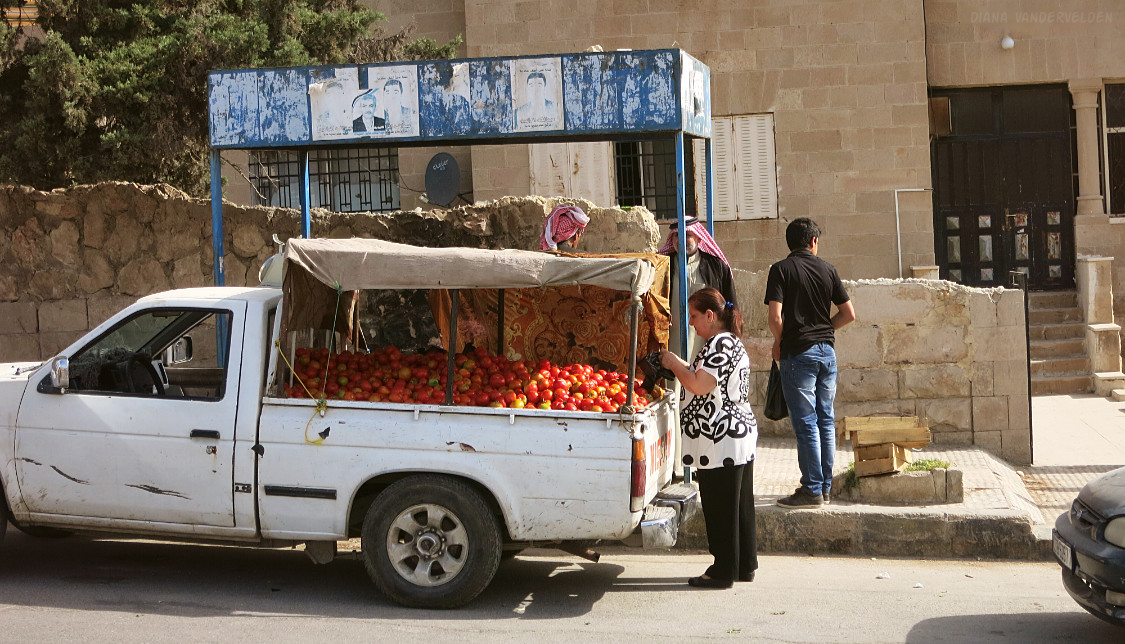
This Jordanian man allowed Diana to take his picture.
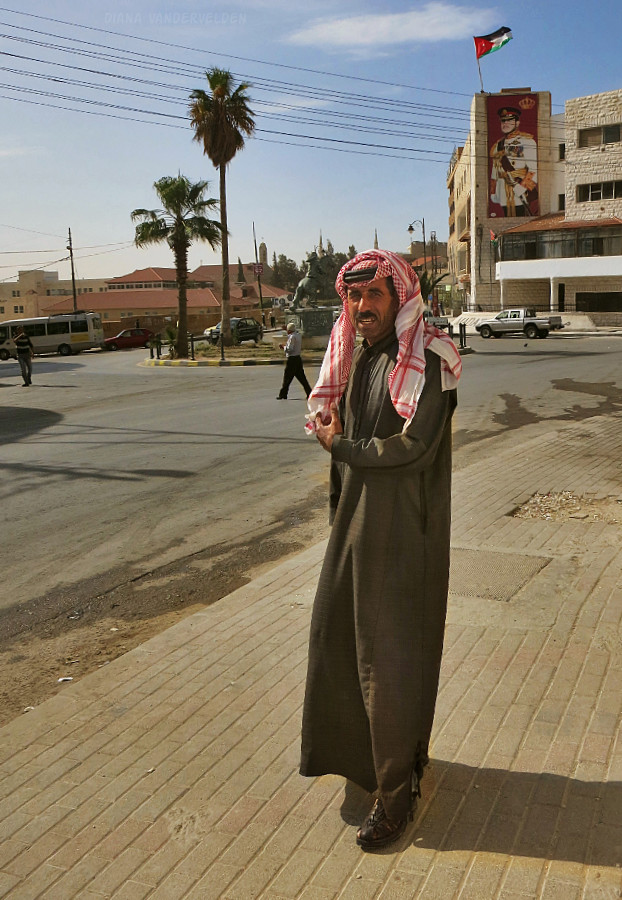
After stocking up we got into our car and drove south, along the King’s Highway. The King’s Highway roughly follows the top edge of the Dead Sea valley escarpment. We passed bustling market towns and deep desert canyons with Bedouin camped out in places.

The plateau above the canyons is surprisingly green, and people try to farm the desert soil. The wadis (canyons) are quite barren and rocky. We saw many shepherds with sheep and goats (very biblical-looking), and we also saw camels grazing in paddocks.

We visited a ruined crusader castle at Karak.

After visiting the castle, we had an excellent lunch of tabbouleh, pita, hummus, yogurt, and freshly squeezed blood oranges. Very fresh. Yum.
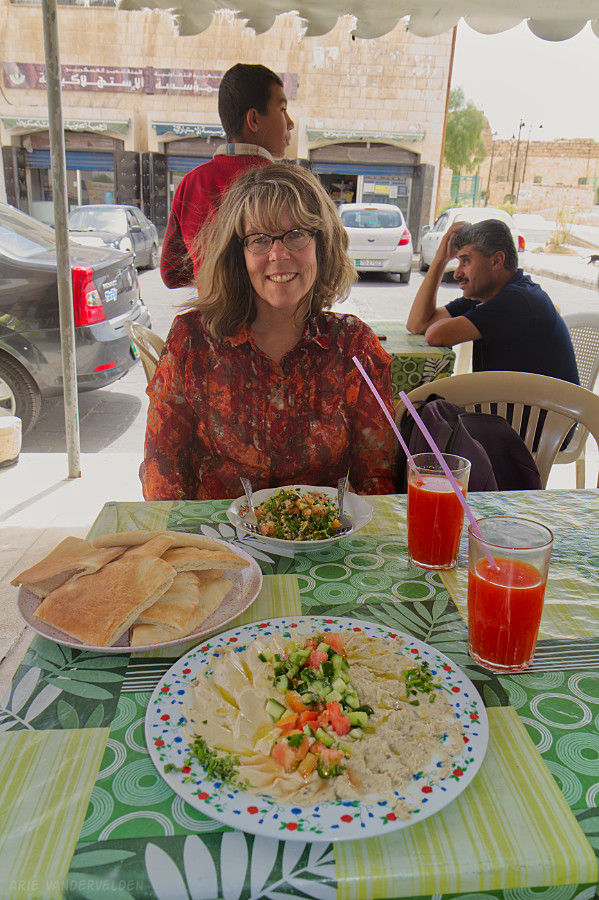
Petra and Wadi Rum
We ended the day at Wadi Musa, the gateway town to Petra. We spent two days hiking in Petra, the spectacular Nabatean city, which I relate in two separate posts. After Petra we visited Wadi Rum, a desert area made famous by TE Lawrence. Here we took a one-day one-night tour with an outfitter. The tale of our adventures is in these separate posts.
Aqaba
After Petra and Wadi Rum we drove to Aqaba, Jordan’s port town on the Red Sea. During World War One, Aqaba was famously captured from the Ottoman Turks by T.E. Lawrence and his Arab compatriots. The movie ‘Lawrence of Arabia’ depicts the famous battle. We spent our time dipping our toes in the sea. The water felt great after having spent a few days in the dusty desert.

From the shore of the Red Sea at Aqaba you can see four countries: Jordan (beneath my feet), Israel (on the opposite shore to the right), Egypt (on the opposite shore on the left), and Saudi Arabia (just down the coast from Jordan).
Dana
We drove to Dana, an old stone village that was once abandoned but is currently being restored and promoted as a hiking destination.
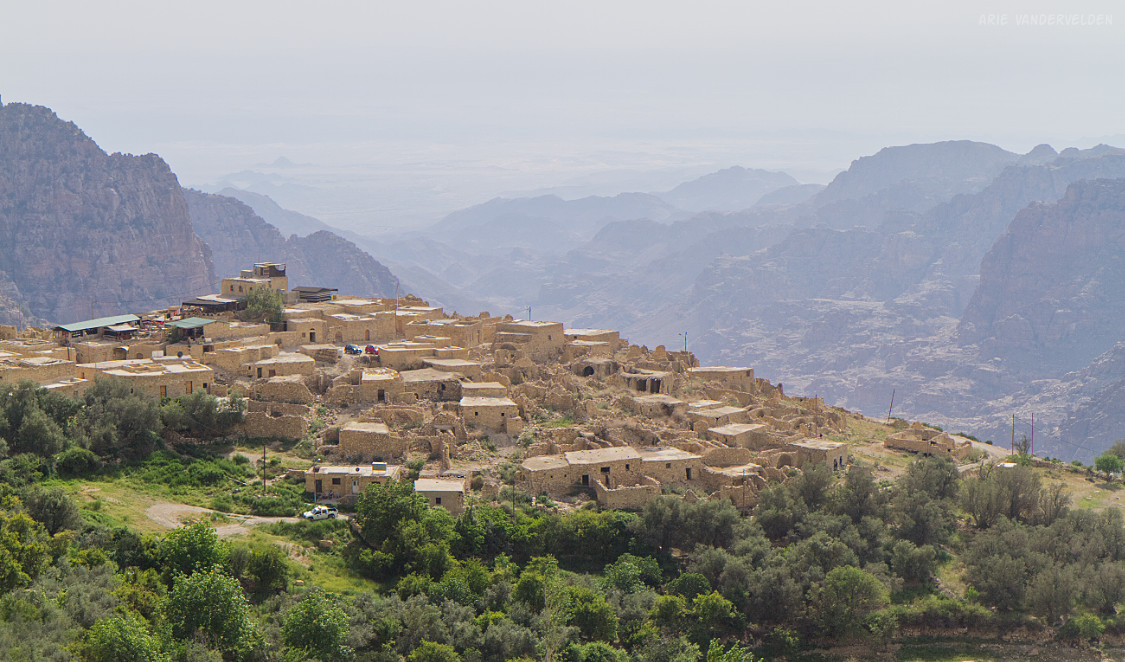
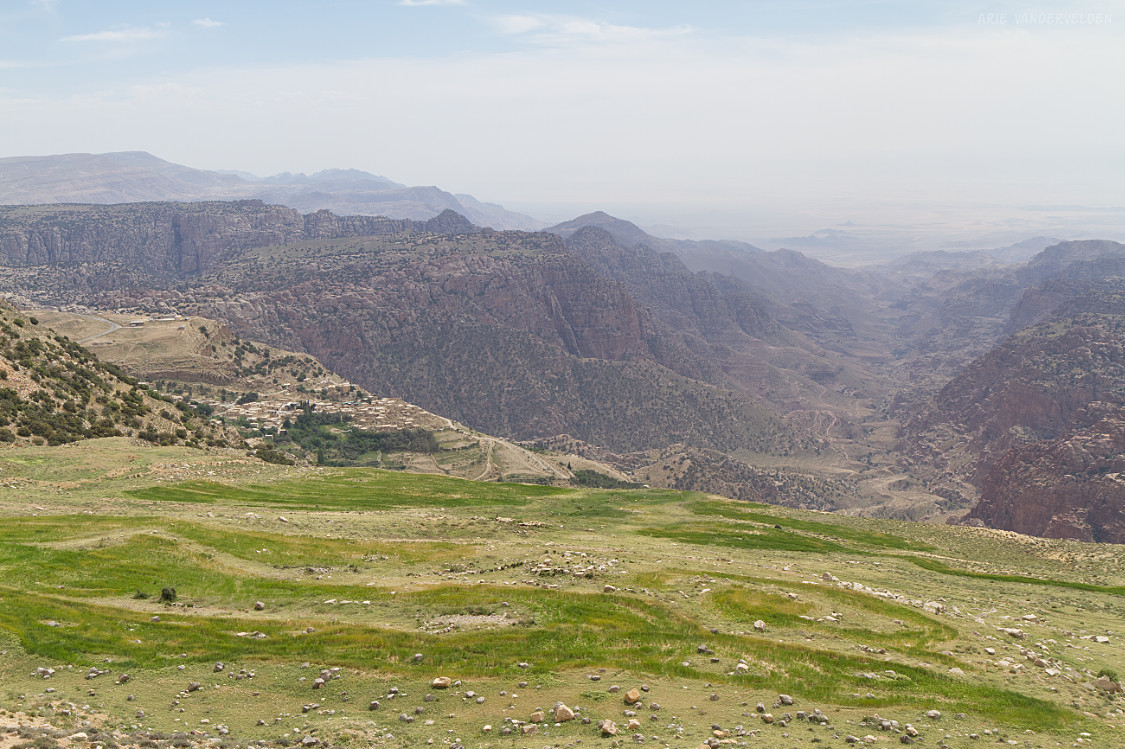
It’s a bit of a tourist trap, and some people we talked to wonder what all the fuss is about. We stayed in a ramshackle overpriced hotel. In the morning we hiked a ways down the canyon, on a jeep trail that was bulldozed too steep and is now mostly washed out.
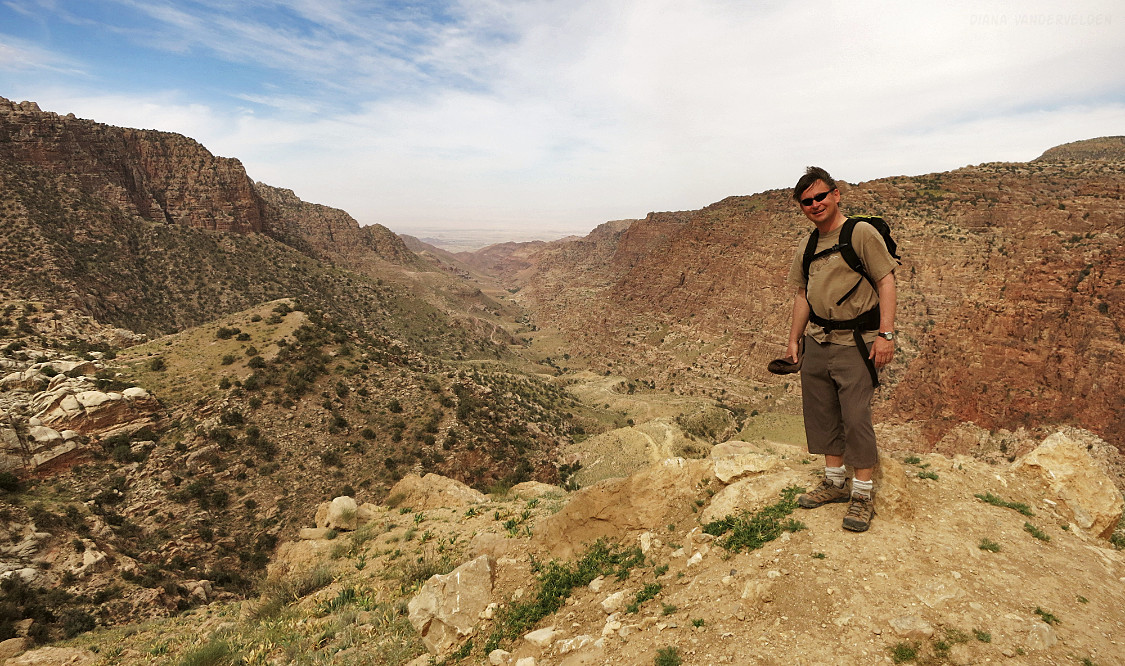
We turned around, went back up, had lunch, and considered our options. There was supposed to be a hike along a canyon rim a bit further up the road. As we drove out of town we got flagged down by a Bedouin farmer, and we gave him a lift up the steep road up to the main highway. We drove on to the hiking place, but as it turned out the hike was a complicated affair involving jeep shuttles, guides, and steep fees. We said no, turned around, and drove to a viewpoint along the highway deciding what to do.
At the viewpoint we were enjoying a cup of tea which we had bought from a little boy running a tea stall. As we were sitting there, a bunch of young men pulled up in their cars, their stereos blaring Arabic pop music. They were snapping pictures with their phones, posing. They were not really paying attention to a couple of western tourists, but on a whim I walked over and offered to take a picture with all of them in it. Their faces lit up, they gave me their phones, and I snapped pictures while they were horsing around. They got back into their cars and drove off down the road.
We decided to check out a spring which had been pointed out to us by the hotel owner. As we walked up to the spot we met the same boys again. They had laid out a blanket, and in the middle was a gigantic dish with spiced rice, beans, and chicken. They were about to have a picnic lunch. Immediately they recognized us, asked us to sit down on their blanket, and offered to share their food with them, which we did.

Their English was limited and our Arabic is pretty much non-existent, but we managed to tell them that we are Canadians, and we managed to figure out that they are university students from a nearby town. Several of them were studying art restoration, and restoration of Byzantine mosaics. We sat with them for some time, all of us being ambassadors to our countries, the boys saying over and over: “welcome to Jordan we hope you like”, and us telling them: yes we do like Jordan, beautiful country, friendly people, thank you so much or your hospitality.
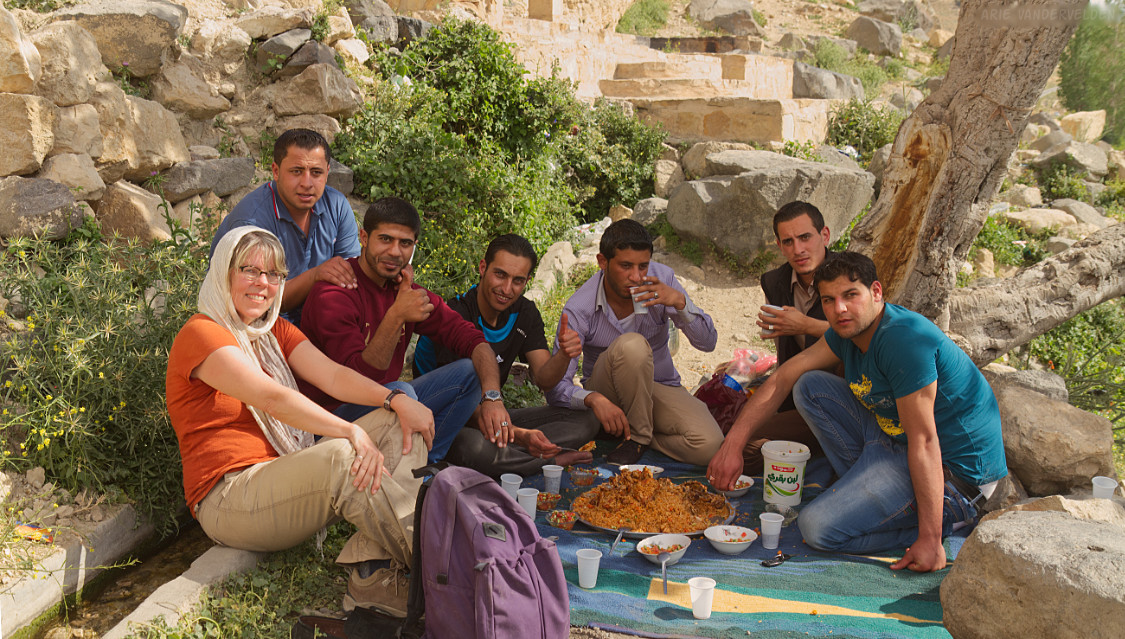
After a while we exchanged email addresses and said our goodbyes. Just down the trail was another Jordanian family on an outing, a husband and wife and their three children. They spoke good English and we struck up a conversation with them. Before long they invited us to come stay at their house in Amman. It was very endearing. After chatting for a while we said our goodbyes, and we went back into town.
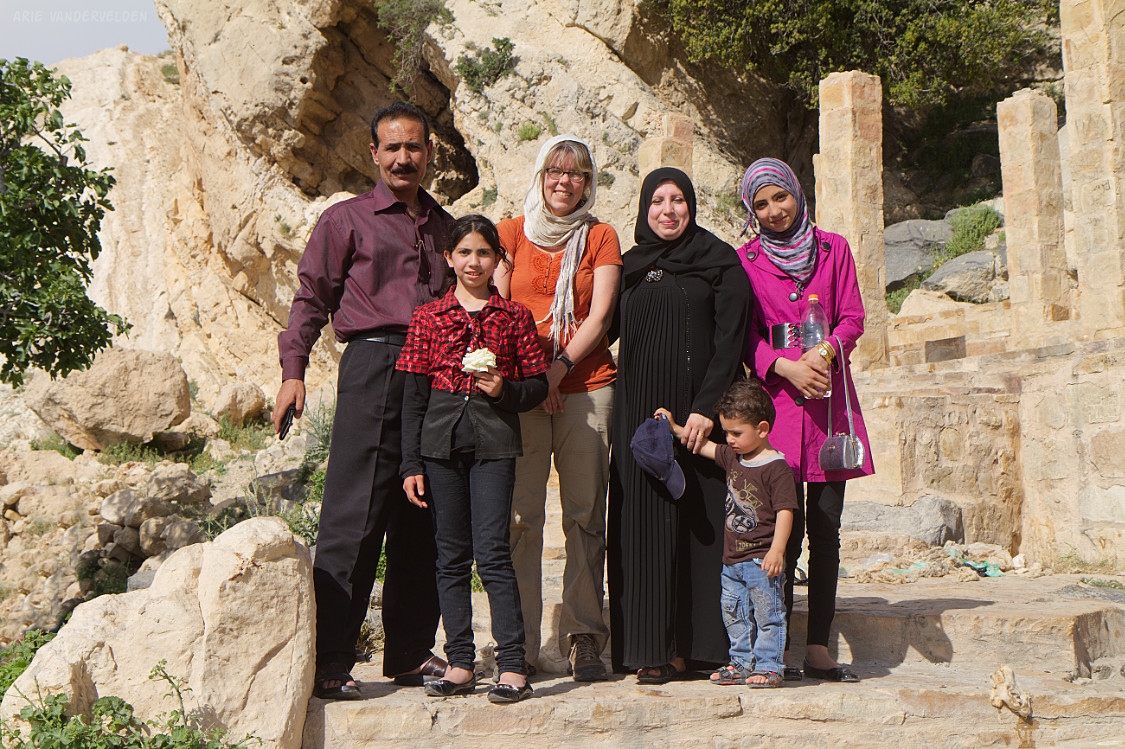
I used to enjoy watching the tv show “My Name Is Earl”. Earl always goes on about karma, and giving the Bedouin farmer a ride may have swung karma in our favour. Sometimes when traveling you expect one thing but then something else happens. We expected to be hiking, but ended up on a little cultural exchange instead. It was a wonderful and memorable afternoon.
At sunset we found a quiet spot at the edge of town overlooking Wadi Dana toward the Dead Sea rift valley. We listened to the sounds of goatherds shouts in the distance, the tinkling and clanging of the goats bells, a cuckoo calling, and the distant sound of a shepherd playing a flute and singing. It was magical.
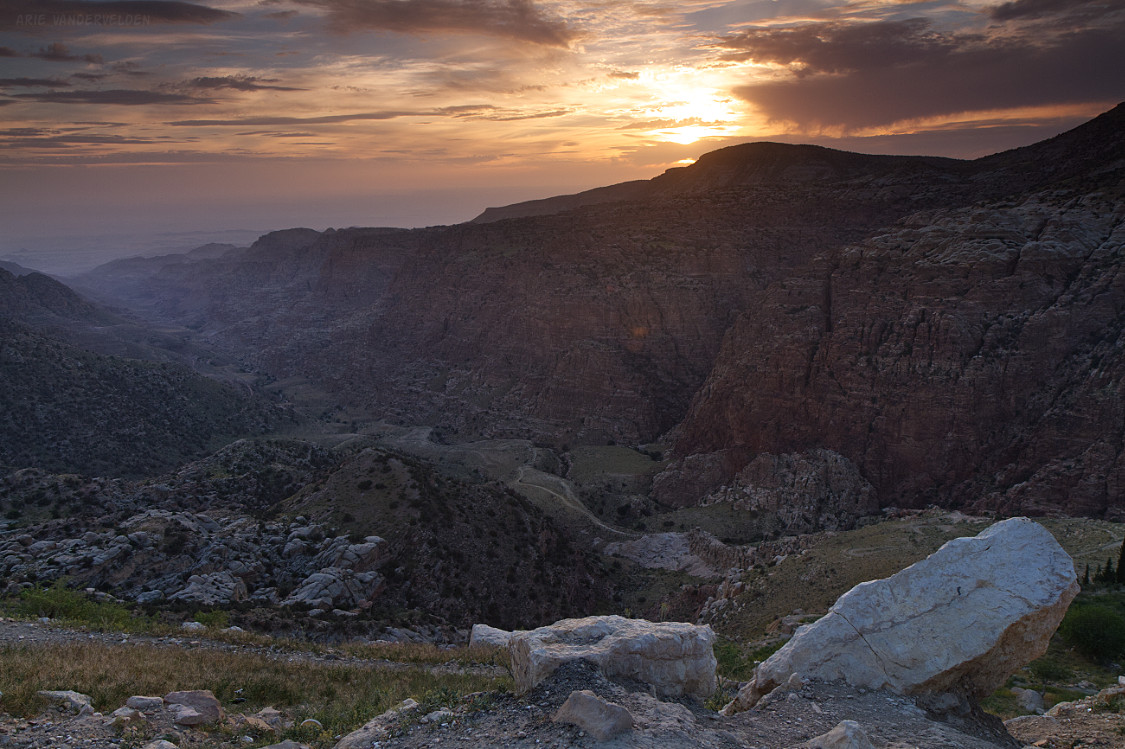
Dead Sea
After our stay at Dana we drove to the Dead Sea. I had read about a back road near Wadi Musa that’s supposed to be very scenic, but in our guidebook it said that “at the bottom of the hill the pavement is a bit broken”. That didn’t sound too bad. We started off down the road and everything was as promised: a smooth, gentle, and well-paved little road with outstanding scenery, winding its way through the sandstones on the outskirts of Wadi Musa. But after a while the pavement ended, and we found ourselves going down on a steep potholed gravel road.
I slowed right down and very gently and slowly drove down, trying to avoid the sharp rocks, trying to avoid a flat tire. There were some other vehicles coming up the hill, but they were all 4x4s so we were getting a bit concerned. Then, in my rear-view mirror I saw another small car coming up behind us. I pulled over, let them pass, and saw that they were local Bedouin. This was some relief: the locals obviously know the road, and it can be done with a small car with bald tires.
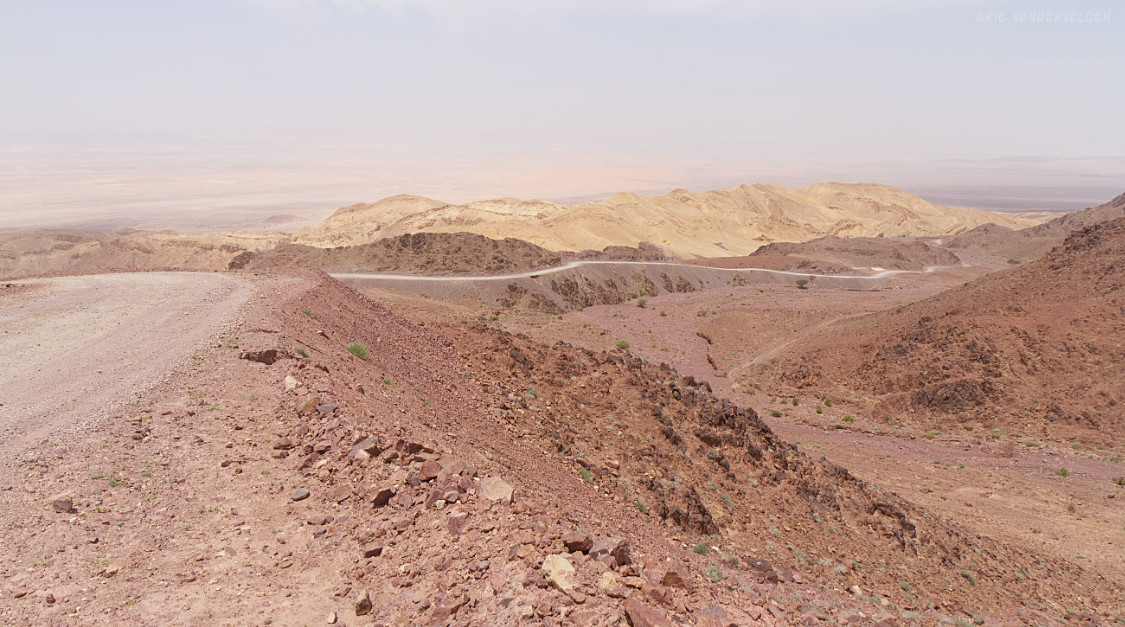
We kept on going, crawling down the hill, and eventually hit pavement again. The temperature kept rising as we descended further, eventually topping out at 43C near the Dead Sea highway.
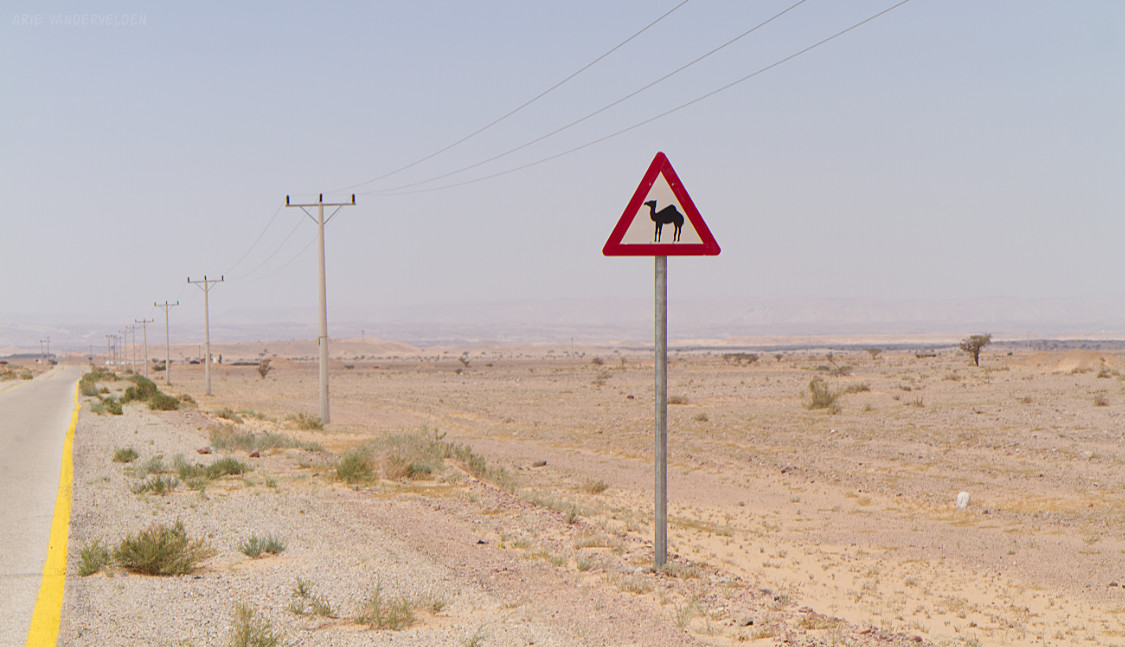
The Dead Sea valley was searing hot – well above 40 degrees when we drove through it. We first drove through some stony desert and sand dunes. We were amazed to see Bedouin tents and goatherds. We asked ourselves how these people can survive in this climate – imagine how hot it’ll be here in July!
Further up the road we were surprised to come across an agricultural area, where the desert soil is irrigated to produce crops of melons, tomatoes, and other vegetables. This area seemed quite poor compared to other parts of Jordan. We drove past Lot’s cave, where Lot’s wife turned into a pillar of salt. We then drove past some salt works (potash and bromine) at the dried-up northern edge of the Dead Sea. Just ahead, we stopped to take some pictures.
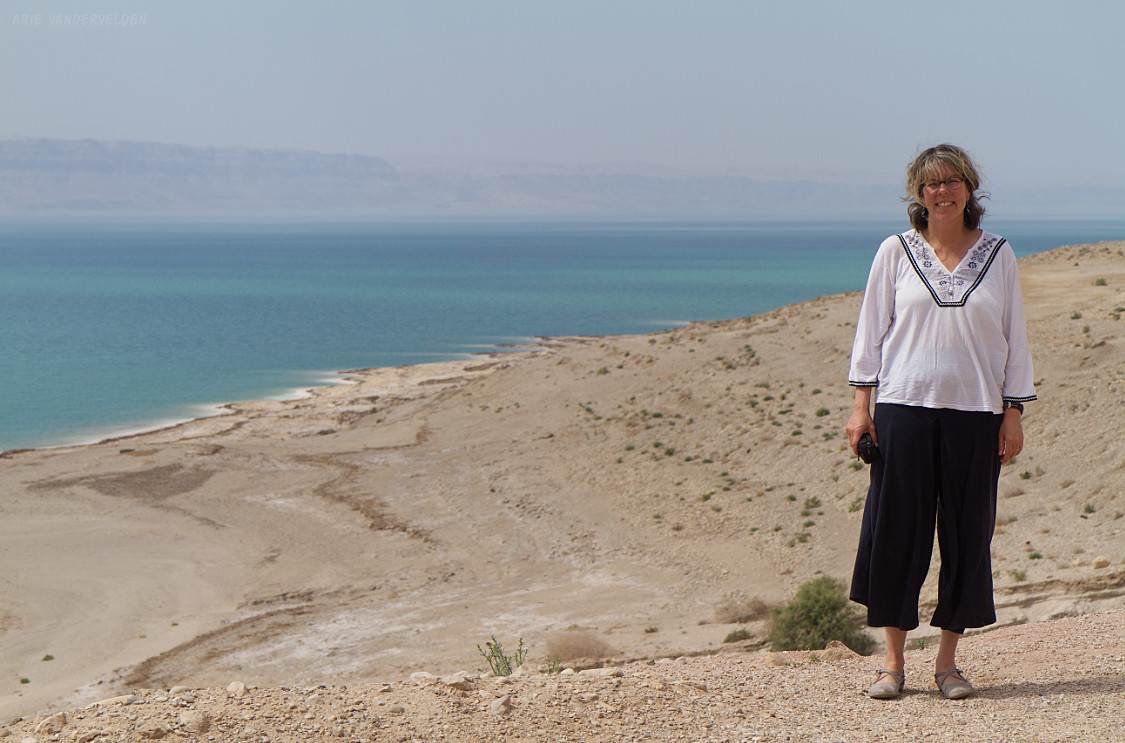
We had booked a room at a posh resort along the shoreline. We checked in and went down for a “swim”. I’m sure you’ve seen pictures of people reading the newspaper while floating around, and indeed it’s just like that.
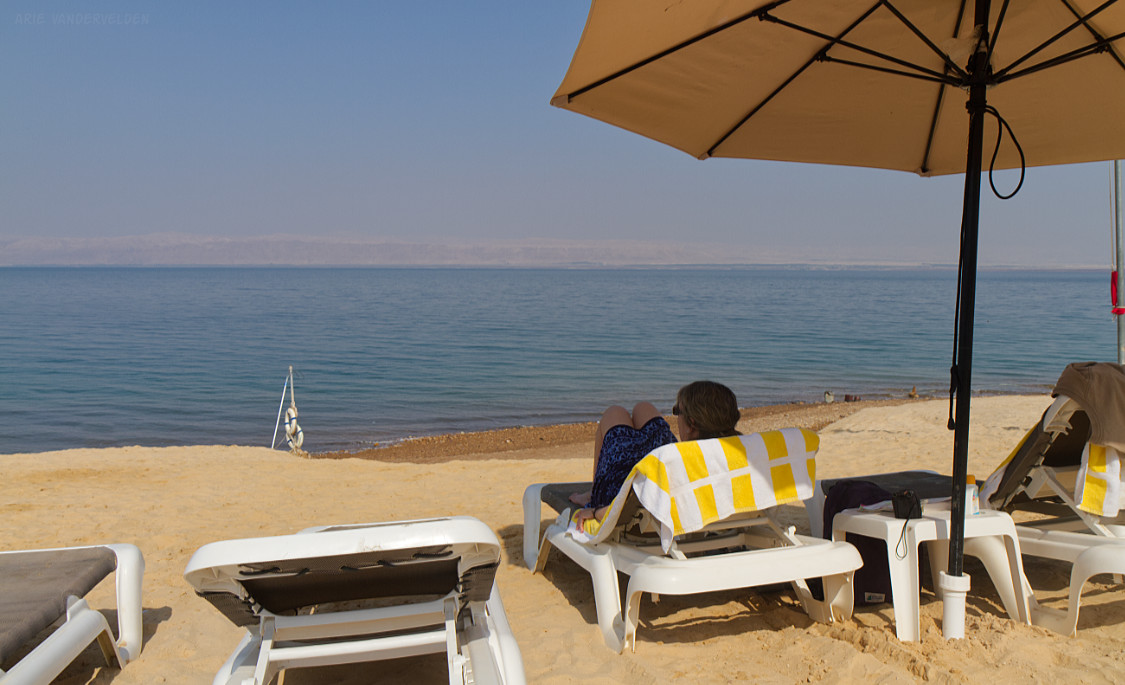
The Dead Sea is not really a sea but rather a hypersaline lake. The water has more than nine times the salinity of regular sea water, and as a result it’s very dense and viscous. Human bodies are very buoyant in the brine. If you run your hand through the brine it feels more like mineral oil than water. The viscosity also dampens waves, and the surface of the sea looks more like blue oil than water. You better not have any scrapes or cuts, because they sting like mad when you immerse yourself in the brine.
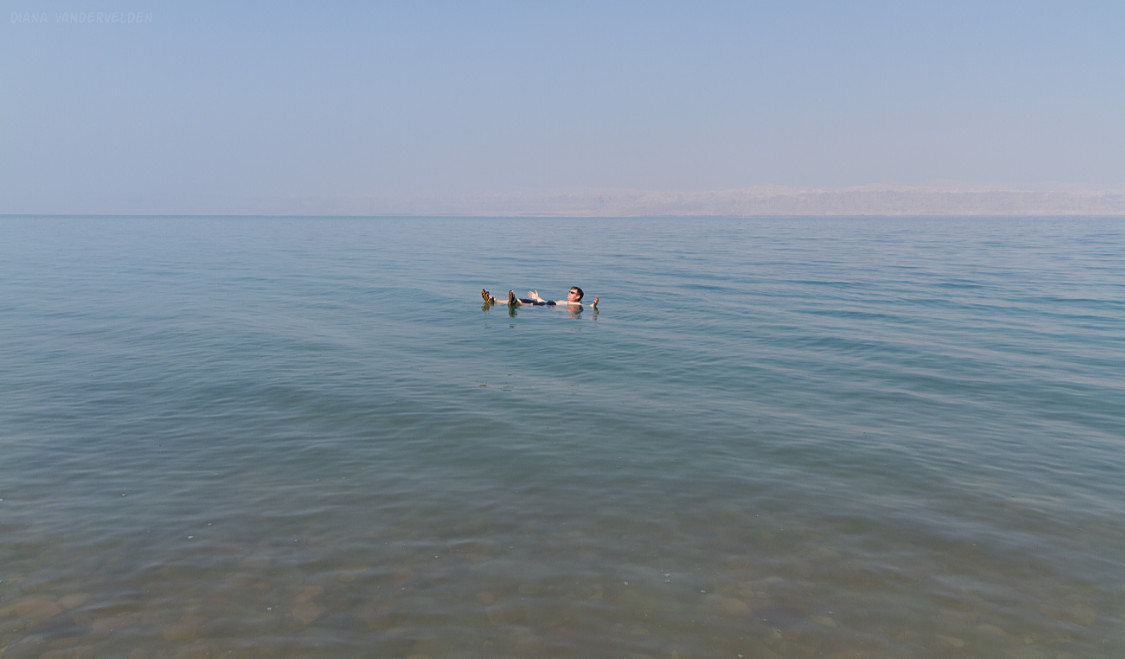
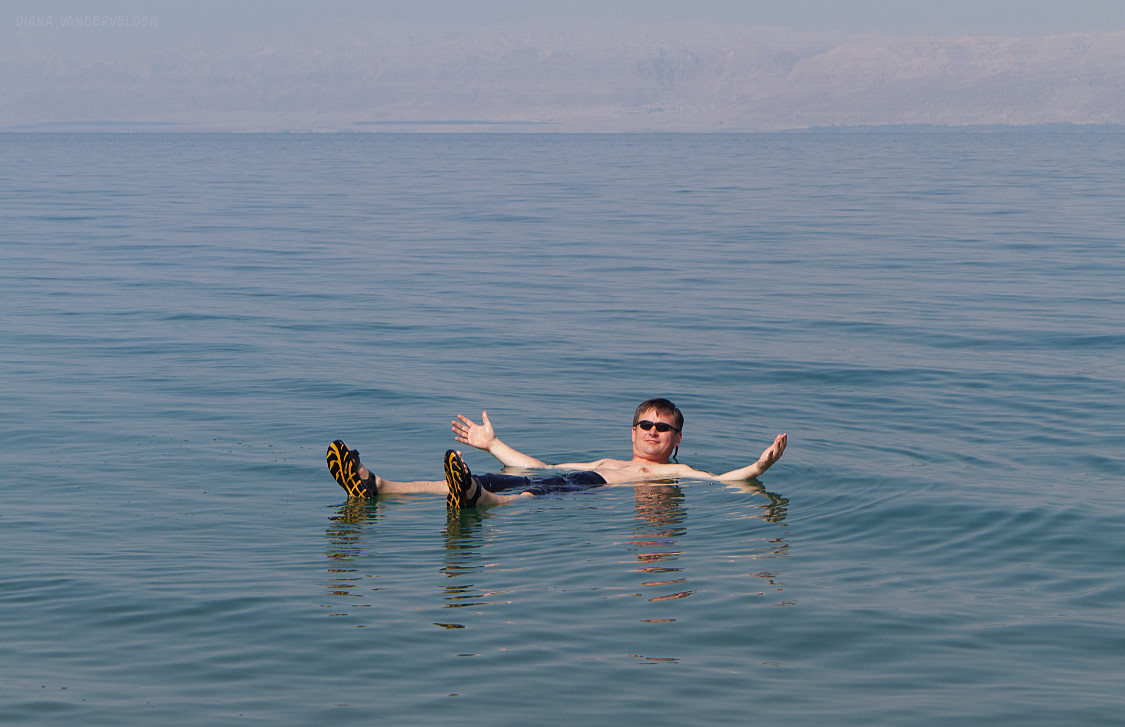
Swimming in the Dead Sea is an odd, otherworldly experience. You sit down in the brine and paddle around with your hands, just as if you’re sitting in an inner tube. Keeping your sitting position in the water is actually a good stomach-muscle workout.
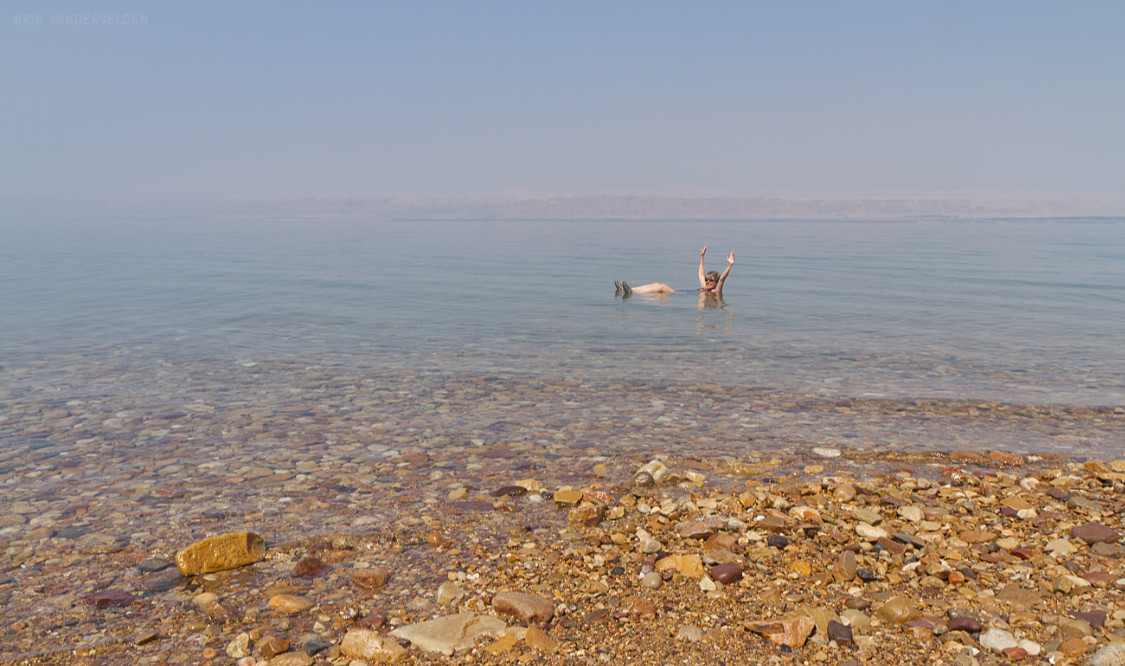
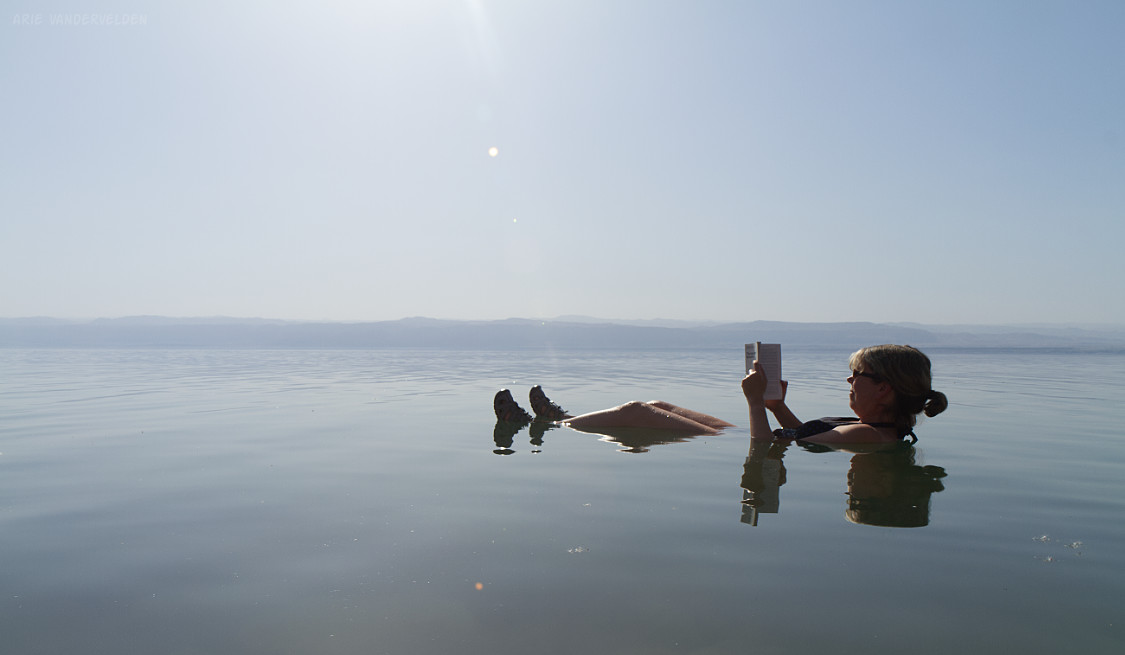
At 427 m below sea level, the Dead Sea is also the lowest point on Earth. We joked about it being the low point of our trip, but in fact we really enjoyed ourselves there. The sunset was spectacular.


Our hotel had a Lebanese restaurant where we had a nice alfresco meal. Our room was very comfortable, compared to the basic hotels we had stayed in so far. In the evening we watched the lights on the other side of the Dead Sea, in Israel. In the distance we could see the lights of Jerusalem and Jericho.

Madaba and Mount Nebo
On Saturday we enjoyed the hotel facilities in the morning, and then drove back up onto the plateau towards Madaba. On the way we stopped at Mount Nebo, a hill overlooking the northern end of the Dead Sea and the Jordan Valley. Here, Moses showed his people the promised land. Moses had come all the way from Egypt with the Israelites, looking for a new place to live after the Egyptians had expelled them. Moses pointed the way to the Jordan and Jerusalem before dying at this very spot, 120 years old but ‘still virile and of good eyesight’ according to the bible. There is a memorial stone for Moses and the ruins of an old Byzantine church which was closed for renovation.
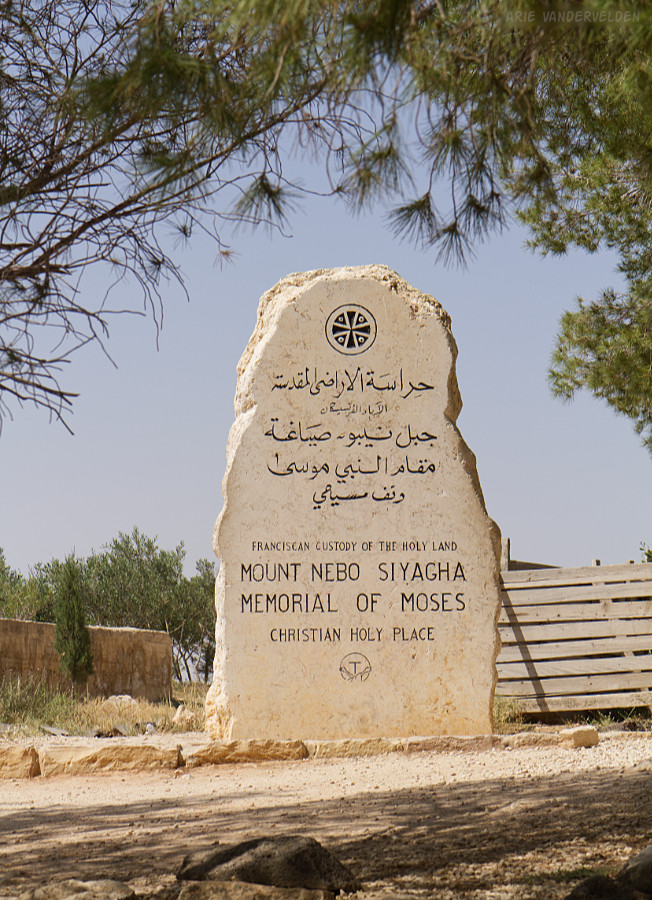
On top of Mount Nebo is a lookout with a plaque pointing the way to Nablus, Hebron, Jericho, Ramallah, and Bethlehem. We tried to picture Moses standing here, surveying the Promised Land.
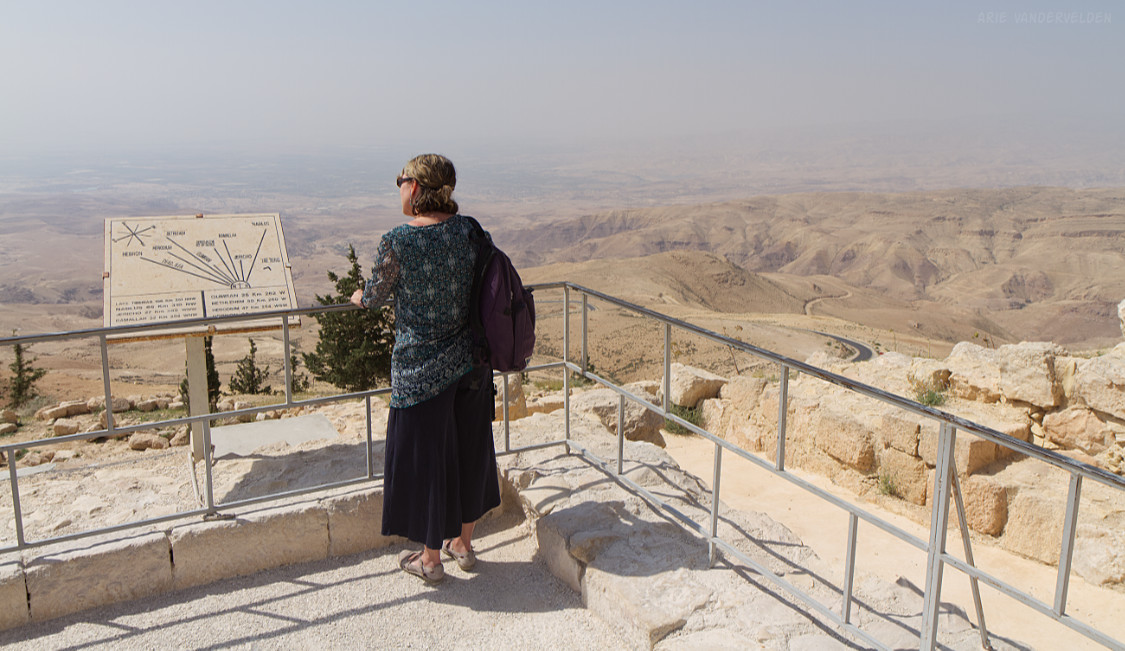
Nearby Madaba is an interesting town. It has a significant Christian population, who live in relative peace among the Muslims. Here the clanging of church bells competes with the call to prayer from the minarets. This coexistence is a source of pride for Jordanians. We climbed up a tower to get a view of the city.
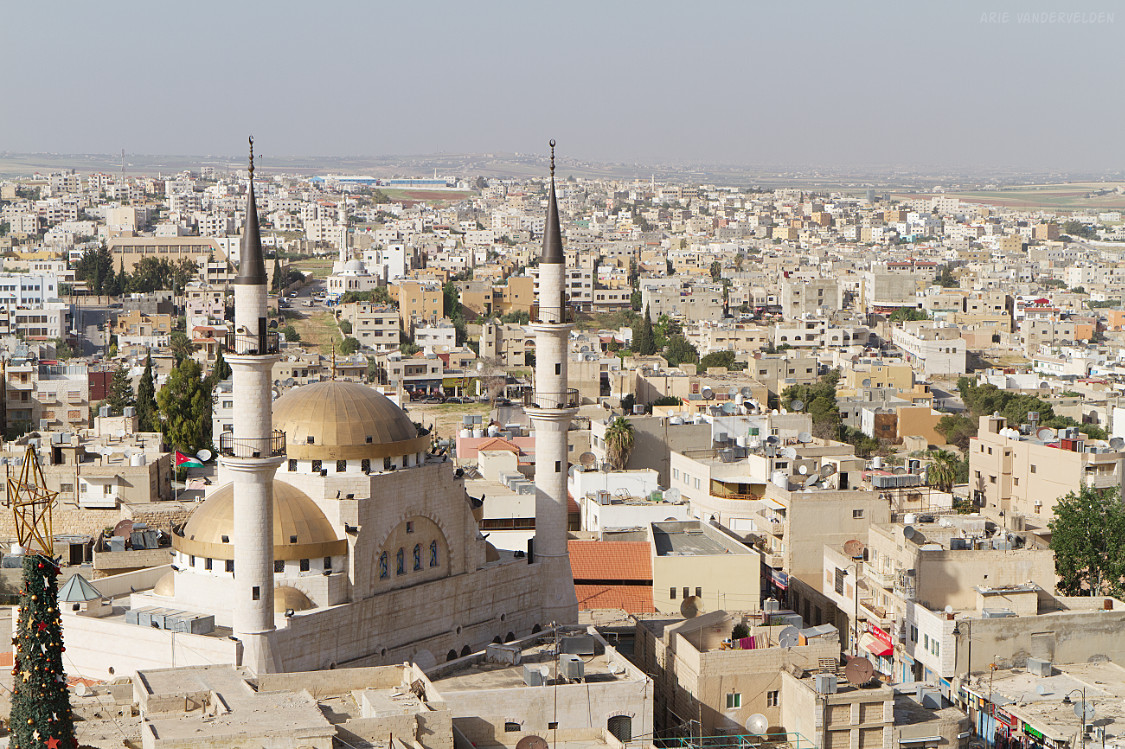
Madaba has a Byzantine-aged church with a very famous floor mosaic. The mosaic depicts a map of the world, as it was 1500 years ago. At the top of my photo you can see the Dead Sea, with the river Jordan flowing into it on the left. The walled city in the center is Jerusalem.
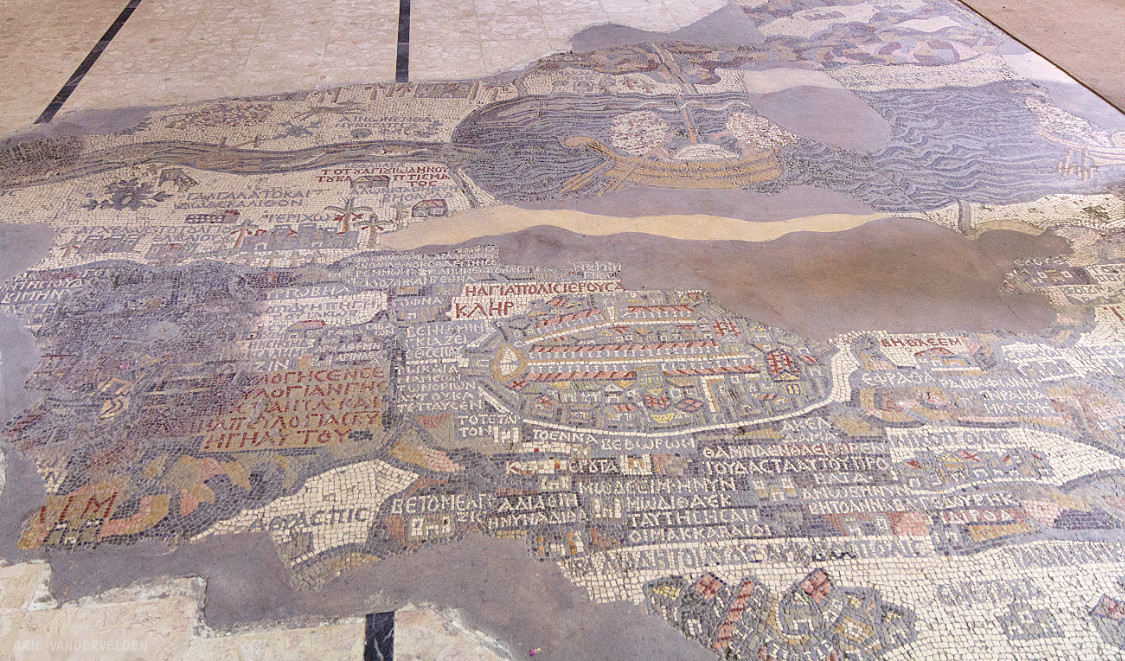
Our guesthouse had a balcony which offered nice views.
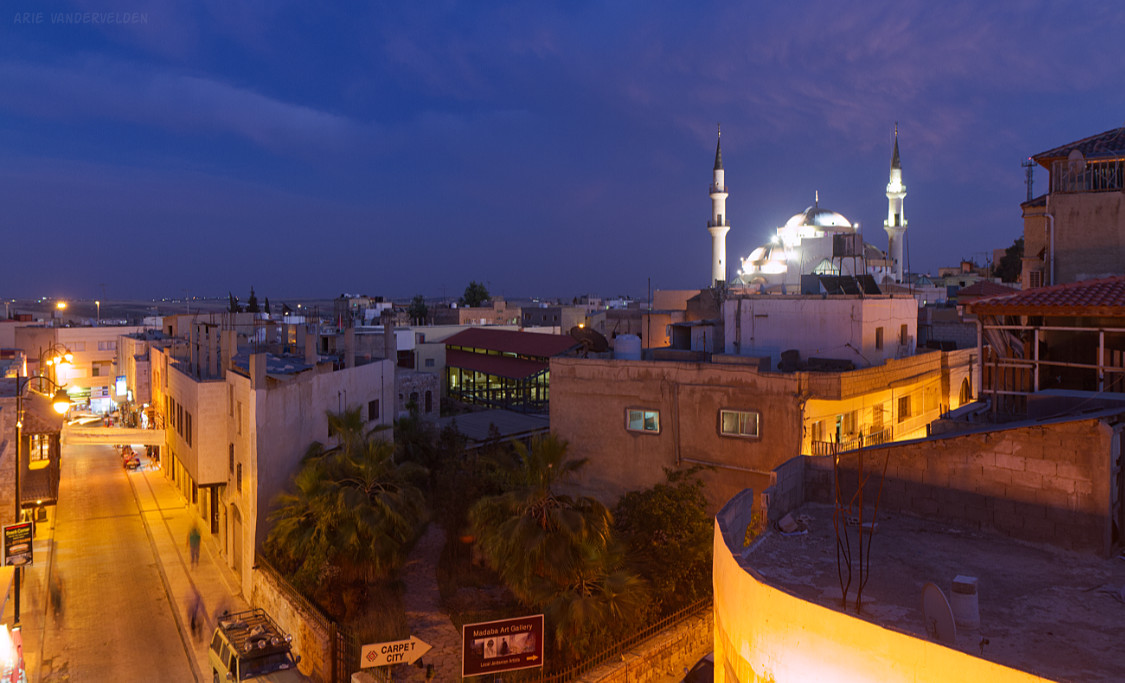
We left the hotel at five am to go to the airport to fly back home. It was an an amazing trip: very exotic, superb scenery and very nice people. We’re glad we went.
Logistics
We flew to Amman on Royal Jordanian airlines from Amsterdam. These days there are some discount airlines flying into Jordan, including Easyjet (to Aqaba).

Self-driving in Jordan is pretty straightforward. This is what we did and I recommend it. There are major rental agencies at Amman airport. Tourists are advised not to drive into downtown Amman. Luckily the airport is south of Amman so there is no need to drive through the city.
Three major tourist attractions in Jordan are Petra, Wadi Rum, and the Dead Sea. All these can be visited with a one-week itinerary. Another major sight in Jordan are the Roman ruins at Jerash, near the Syrian border. We did not visit this area. We managed to cover most of Petra in two full days -one day is simply not enough time. Also, an entrance ticket for two or three days doesn’t cost a lot more than a single-day entry. You’d be silly to come this far and spend only a day at Petra. For two full days of hiking you’ll need to book three nights of accommodation in a local hotel (Wadi Musa). At Petra there is a big parking lot at the visitor center. Tickets can be bought at the visitor center.
At Wadi Rum we booked a one-day one-night package with local outfitter Rum Stars. We were extremely pleased with their tour, and highly recommend them. We booked the optional camel ride out for the following day. I really liked this as well, but some people may tire after an hour on a camel.
At the Dead Sea there are a number of big, expensive, international hotels. We stayed at the Crowne Plaza. It’s a splurge, but it’s worth it. We stayed only one night, and this gave us a good idea what swimming in the Dead Sea is all about. Some people stay longer to enjoy some R&R. Note that security is very tight at these big hotels. There is airport-style security, and you can’t bring your own bottled water.
Our itinerary was as follows:
- First night at Madaba. Salome Hotel – highly recommended.
- Three nights at Wadi Musa (Petra). Rocky Mountain Hotel – okay.
- One night at Rum Stars camp (Wadi Rum). Highly recommended.
- Two nights at Tower Hotel, Dana. Okay.
- One night at the Crowne Plaza, Dead Sea. Recommended.
- One night at Pilgrims Guest House, Madaba. okay.

We traveled to Jordan in late April of 2014.
